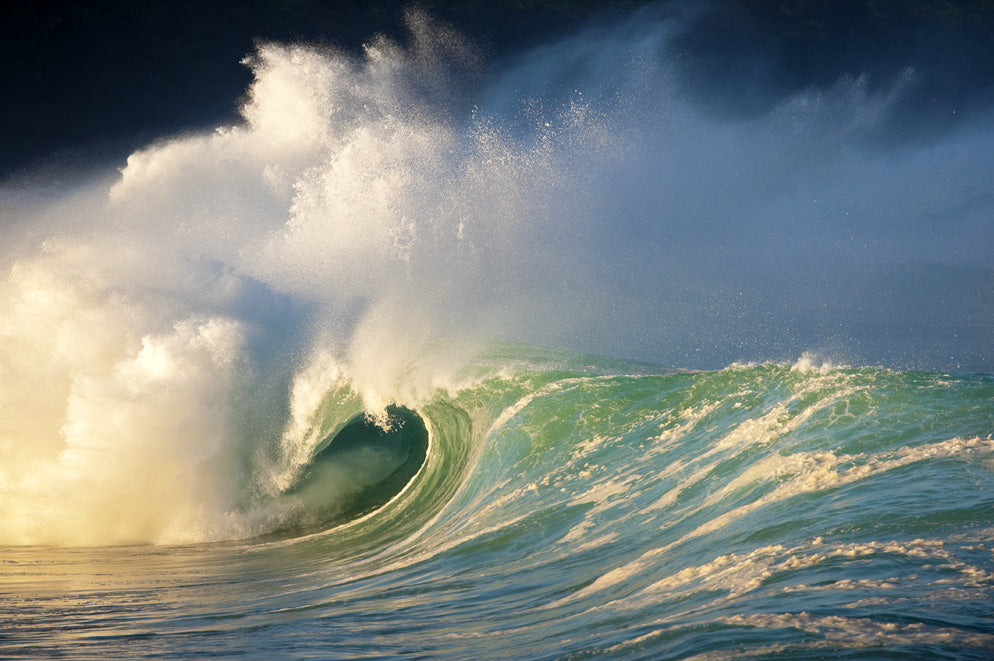When it comes to action sports, there are a few basic camera settings and features that cannot only make or break an image, but with a little planning can help make an outstanding image. Let’s talk about four camera features that I use often to create distinctive action sports images: a high framing rate; high ISO settings; rear curtain sync mode with SB Speedlights; and advanced autofocus modes.
 Waves exploding in Waimea Bay on the north shore of Oahu, Hawaii. D700 with MB-D10 battery grip, AF-S NIKKOR 500mm f/4G ED VR, 1/2000 second, f/5.6, ISO 400, aperture priority, Matrix metering.
Waves exploding in Waimea Bay on the north shore of Oahu, Hawaii. D700 with MB-D10 battery grip, AF-S NIKKOR 500mm f/4G ED VR, 1/2000 second, f/5.6, ISO 400, aperture priority, Matrix metering.Open Wave. It’s nearly impossible to catch split-second moments of peak action by shooting one frame at a time, so when my subject is moving quickly I use the high framing rate of my cameras to get an entire sequence of images. My D4, for example, can capture up to ten frames per second; my D700, up to eight (with an MB-D10 battery grip). With the D700 I shot thousands of images, capturing just about every wave that rolled into Waimea Bay on that day, to get this one photograph, and without the eight-fps framing rate, it would not exist.
 Daniel Bleicher and Rich Cezelski running on the beach at sunset to catch one last wave before packing it in at Ventura Point, Ventura, California. D700, AF NIKKOR 24mm f/2.8D, 1/200 second, f/2.8, ISO 1600, manual exposure, Matrix metering.
Daniel Bleicher and Rich Cezelski running on the beach at sunset to catch one last wave before packing it in at Ventura Point, Ventura, California. D700, AF NIKKOR 24mm f/2.8D, 1/200 second, f/2.8, ISO 1600, manual exposure, Matrix metering.Surfers. The surfers were running to catch one last wave. The sun had already set and it was getting quite dark, so I cranked the ISO up to 1600, which allowed me to use a 1/200-second shutter speed to stop their motion as they ran across the beach. Often when shooting action the whole point is to stop motion with a fast shutter speed. If that action is occurring indoors or outside in very low light or even near darkness, setting a high ISO is the way to get that speed.
 Clay Moseley skate skiing at the Pajarito Nordic Ski area near Los Alamos, New Mexico. D4, AF-S NIKKOR 14-24mm f/2.8G ED, 1/15 second, f/6.3, ISO 50, aperture priority, Matrix metering.
Clay Moseley skate skiing at the Pajarito Nordic Ski area near Los Alamos, New Mexico. D4, AF-S NIKKOR 14-24mm f/2.8G ED, 1/15 second, f/6.3, ISO 50, aperture priority, Matrix metering.X-Country Skier. For this photo I wanted some degree of sharpness to the cross-country skate skier, but I also wanted some sense of everything moving. To blur the background, I first found an area of the forest that was dark enough to allow a slow shutter speed. Then I panned the camera with the skier as he came by. The trick here was using three SB-900 Speedlights to stop his motion and setting my camera for rear curtain sync to slightly blur him. The three SB units, remotely triggered from the camera position, were mounted on a iDC Triple Threat block and fired through an Elinchrom shoot-through umbrella placed about 12 feet to camera right at the edge of the ski trail. A fairly complex image, but it perfectly captured both the side-to-side and forward motion of cross-country skate skiing.
 World class Kenyan marathon runner Caroline Rotich on a late afternoon training run in Santa Fe, New Mexico. D700, AF-S Zoom-NIKKOR 17-35mm f/2.8D IF-ED, ISO 100, 1/160 second at f/6.3, manual exposure, Matrix metering, Elinchrom Ranger strobe.
World class Kenyan marathon runner Caroline Rotich on a late afternoon training run in Santa Fe, New Mexico. D700, AF-S Zoom-NIKKOR 17-35mm f/2.8D IF-ED, ISO 100, 1/160 second at f/6.3, manual exposure, Matrix metering, Elinchrom Ranger strobe.Trail Runner. To keep a fast-moving subject in focus when shooting action sports, I rely on continuous AF mode, in which the camera tracks the subject as it moves. In tandem with that mode on my D700, I use 21-point dynamic-area AF, which allows the camera to track the subject with 21 of its 51 focus points. I used this combination to capture the trail runner as she flew by. I’d chosen a focus point on the right side of the viewfinder, and as she came into frame the AF picked her up and kept her in focus the entire time. For action sports, I almost always use these AF settings, but because there are several to choose from and there are differences in what’s available depending on your camera, I’d suggest testing out your camera’s modes and settings to see what works best for you in various shooting situations.
You might find that combinations of these four features I mentioned will work well for specific situations. Imagine shooting a youth soccer game at night: a high ISO setting, a high framing rate and continuous AF tracking might all come into play. In some instances, all four features might be used at the same time. Understanding how your equipment works and how it responds in different situations are the keys to getting interesting action images.
Check out Michael’s work, his upcoming photography workshops and his latest book, Exposed: Inside the Life and Images of a Pro Photographer, at www.michaelclarkphoto.com. For more photo tips, you can sign up to receive his PDF-format quarterly newsletter.
Courtesy of Nikon Learn and Explore

